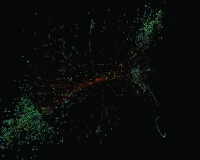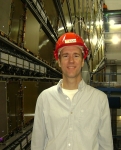 |
 |
|||||||||||||
|
|||||||||||||
|
|||||||||||||
|
Much of the history of particle physics has been devoted almost exclusively to finding out what our bodies are made of. We first learned about protons and electrons and neutrons because they constitute the matter that makes up our bodies, and we learned of photons (light) because it interacts with our bodies when we see. Up and down quarks are the constituents of protons and neutrons, and they are held together by gluons, carriers of the strong force. Neutrons turn into protons through the weak force. Thus, everything we study has a close connection to our physical bodies. Even exotic particles, such as charm quarks or tau leptons are merely nearly exact copies of particles that make up our bodies: only their masses are different.
However, there is no reason to believe that the full richness of nature is so tied to the human form. Cosmology has been our lead on this through the ages. At first we thought everything must revolve around us until Copernicus convinced us otherwise, and we have in recent years been forced to concede that the universe is mostly not made up of the "stuff of us", but rather unknown stuff we often label as dark matter and dark energy. Particle physics is primed to discover exotic new particles and interactions in the coming era. The key to this and the key reason why is the Higgs boson. The Higgs boson is not special just because it gives elementary particles their masses. It is also special because it can be a "portal" to new worlds. The Higgs boson has a unique property: it can couple without large suppressions directly to new, exotic, hidden sector particles that are not part of the Standard Model and are not charged under Standard Model symmetries. Electrons or quarks cannot do this. With the Higgs boson, one can form a gauge-invariant, Lorentz-invariant, and renormalisable operator using only itself. Higgs decays of these couplings will tell us more about not only the Higgs boson but also things that lie beyond the Standard Model. The Higgs boson is likely to be discovered by the Tevatron or LHC in the coming years. This will be a momentous occasion. Soon after discovery, all attention will focus on measuring the properties of this boson. The LHC is expected to be able to measure the mass to within a reasonable accuracy, but is much more challenged in discerning all the various branching fractions of the Higgs boson into its decay products. Perhaps the greatest strength of the ILC is its ability to measure very precisely the branching fractions, the probability that a particle decays into various final states, and decay widths of the Higgs boson and its exotic couplings. This experimental capacity is vital to unlock the portal the Higgs boson provides to new particles. For example, consider the light Higgs boson (i.e. one with a mass less than 160 GeV), which is preferred by precision electroweak data fits. The coupling of this light Higgs boson to all the particles that it is kinematically allowed to decay into happens to be small in the Standard Model. Thus, if the Higgs boson can decay into exotic particles with coupling greater than 0.1, say, these exotic decays will dominate the total branching fraction of the Higgs boson. Careful measurements of all the Higgs branching fractions, including possibly small branching fractions into Standard Model states, will be desired and can be produced at the ILC. In the case that the branching fraction into exotic states is very small — say Higgs boson decaying into dark matter, which is a considered possibility in many theories — we will need to detect an invisible final state branching mode of the Higgs boson. This is challenging at the LHC. For example, with 10 fb-1 (100 fb-1) of integrated luminosity the LHC can reach sensitivity limits of 13 percent (five percent) for a Higgs mass of 120 GeV. In contrast, a sub-500 GeV linear collider can reach sensitivities at two percent with 0.5 percent precision [F. Richard, P. Bambade, LAL-03 (Jan 2007)]. In summary, the Higgs boson, or the particles that play the role of the Higgs boson, should be detected at the LHC and studied at some level. We will need to measure the properties of this most interesting of all elementary particles if we want to explore where the open portal leads us. The ILC is ideally designed for such a purpose, as one of its most obvious strengths is to measure precisely and exhaustively the many couplings of the Higgs boson to the stuff of our bodies and to hidden worlds. -- James Wells
|
|||||||||||||
| © International Linear Collider |

